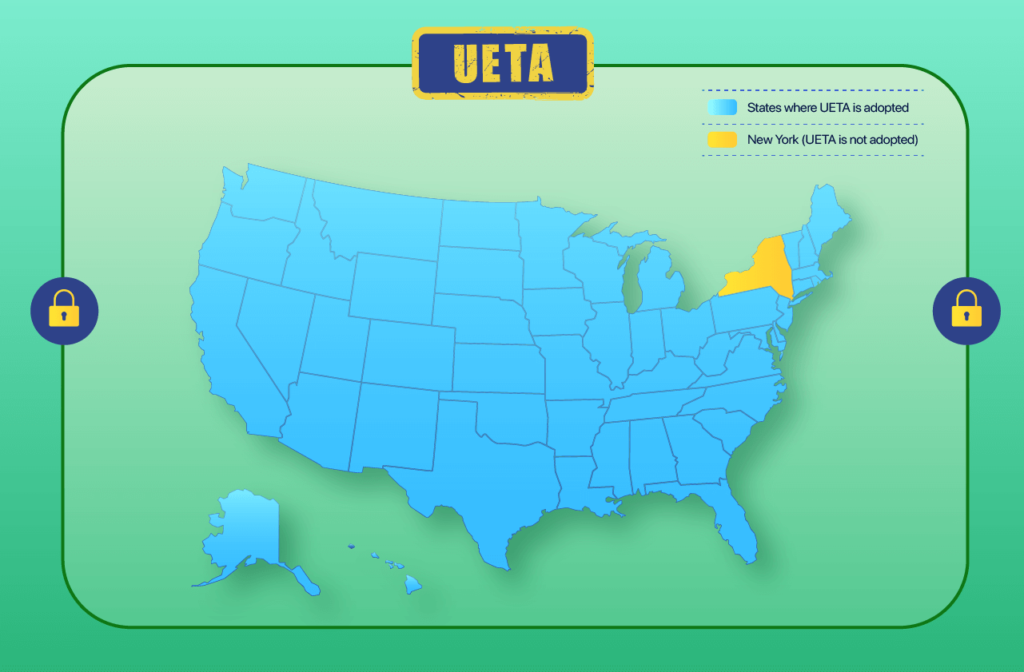

Thou shall not kneel before the power of pen and paper!
Electronic signature technology has liberated businesses from the burdensome task of signing documents using ink and paper.
As Esther Dyson rightly said, “Change means that what was before wasn’t perfect.”
Electronic signatures added convenience and capabilities to process the documentation work from anywhere and lifted the online economy.
From employment agreements and filing loan applications to closing deals with customers – all it takes is a tap/click/touch, and signatures are done.
Are you sure your document qualifies for eSignatures?
Are you aware of the procedural demands to be followed while electronically signing the documents?
The application of electronic signatures differs from country to country. Therefore, you must be aware of the local laws before executing any electronic transaction.
This blog takes a deep dive into the two laws that govern electronic signatures in the United States – ESIGN Act and UETA.
| In this article – |
| Evolution of electronic signatures & adoption of eSignature laws in the United States |
| UETA and ESIGN Act – What makes them similar? |
| UETA and ESIGN Act – What makes them distinct? |
| What constitutes an electronic signature as per UETA and ESIGN Act? |
| UETA and ESIGN Act requirements that make an electronic signature legally binding |
| Are there any exceptions to the UETA and ESIGN Act? |
| Revv | Your eSignature partner in executing ESIGN Act and UETA compliant agreements |
| Conclusion |
From wax seals, copperplate scripts, pictographic scripts to electronic forms – signature methods have gone through a radical change.

The Uniform Electronic Transactions Act (UETA), a state law, was established in 1999 to define the legal framework to facilitate both government and commercial transactions.
Which states have adopted UETA and which haven’t?
49 states have adopted the regulation alongside the US Virgin Islands, the District of Columbia, and Puerto Rico. The only state that hasn’t embraced the Uniform Electronic Transactions Act is New York.
Is there any law that ensures the enforceability of eSignatures in New York state?
Yes, all individuals and businesses from public or private sectors must comply with the New York Electronic Signatures and Records Act (ESRA) to apply or accept electronic records and signatures within New York jurisdiction.
As stated in the Act – “The purpose of the Electronic Signatures and Records Act (ESRA) is to facilitate eCommerce and e-Government in New York State by giving electronic signatures (e-signatures) and electronic records (e-records) the same force and effect as signatures and records produced by non-electronic means.”
The ESRA grants electronic signatures and electronic records the same legal weightage as their paper cousins, subject to certain exceptions specified in ESRA.
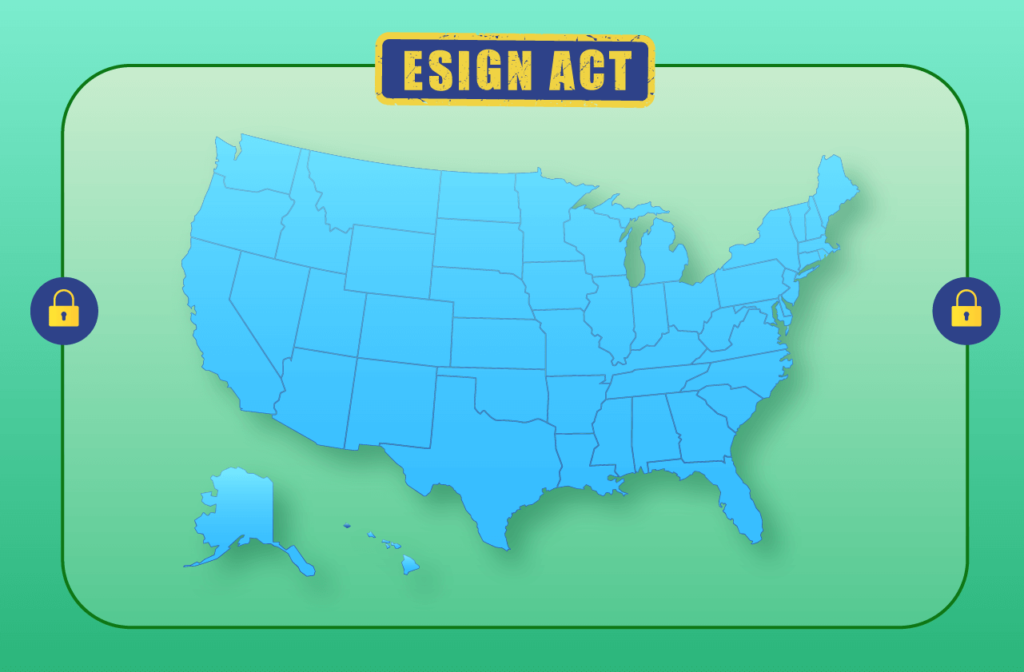
On June 30, 2000, the US government passed the Electronic Signatures in Global and National Commerce Act (ESIGN) and made it a federal law.
The ESIGN Act gives e-signatures the same legal effect as handwritten signatures in all the states of the US or the territories where the federal law applies.
Following are the commonalities shared by both these regulations. Both UETA and ESIGN Act:
Here are some key pointers that differentiate both the acts:
![]()
According to UETA and ESIGN Act, an electronic signature is defined as “electronic sound, symbol, or process attached to or logically associated with a record and executed or adopted by a person with the intent to sign the record.”
Let’s decipher this definition bit-by-bit and understand what each term means:
Checked an “I agree” box while installing a software?
Clicked on the “Place order” button during online shopping?
Signed an invoice with a digital pen pad device at a point of sale?
Checkboxing “I agree” or tapping on “Place order” denotes the ‘symbol’ part of eSignature.
In fact, the word ‘symbol’ means any legally valid form of electronic signatures, which includes clicking on the yellow signature box, confirmation via emails, adding a signature image, sending a scanned PDF of a handwritten signature, and typing in a ‘conformed’ signature.
At the core, adding your electronic signatures to a contract or any other document dictates that you agree to all the provided terms and conditions. It also means that now the laws bind the business transaction between you and the other party.
The affirmation sent by businesses and users through a verbal (voice or video) note is also deemed as valid and equivalent form of electronic signature.
However, voice signatures are only considered valid when they comply with certain terms, which include:
| Quick Bite: The verbal signatures have played a key role in the roll-out of the Affordable Care Act (ACA) by accepting telephonic applications and signatures in Medicaid and Children’s Health Insurance Plan (CHIP) programs. |
The electronic process detangles the ‘how’ aspect of electronic signatures. Think of it as a witness making note of every step taken to affix and record electronic signatures.
When a plaintiff demands legal action claiming one of the below scenarios, the court’s judgment heavily relies on attribution and process.
“I didn’t sign this contract.”
“These aren’t my signatures.”
“My signatures are forged.”
In order to be certified as valid, the system used to sign documents must record the process of signature creation and each step taken by the signer to execute the transaction.
1. Zakuski v. General American: In this case, the recorded electronic process confirming a switch in insurance beneficiary was justified as adequate for showing intent.
Once affixed, a wet signature becomes an inseparable part of the physical paper and stays there forever. Similarly, the linking of an electronic record to an electronic signature is required during transmission and storage.
As stated in the law, the term “record” means information
As stated in the law, the term ‘‘person’’ means an individual, corporation, business trust, estate, trust, partnership, limited liability company, association, joint venture, governmental agency, public corporation, or any other legal or commercial entity.
![]()
There are four crucial and also standard requirements in UETA and ESIGN Act that ensure your document is legally compliant in the United States:
“Are you certain about signing this document?”
“Do you want to opt out?”
Like their paper-based equivalents, electronic signatures are only valid when a signer displays a willful intent to sign.
The parties to the transaction must either display or imply their consent before transmitting information electronically.
Remember the “attached to or logically associated with” part in the e-signature definition? It means that the eSignatures must be connected to the signed document.
An eSignature qualifies this requirement when:
The electronic signature vendors accomplish this by providing electronic evidence with a complete audit trail of each transaction – signer’s details, date and time stamp of each action taken, geolocation capture, IP address, and authentication process.
(a) An electronic record or electronic signature is attributable to a person if it was the act of the person. The act of the person may be shown in any manner, including a showing of the efficacy of any security procedure applied to determine the person to which the electronic record or electronic signature was attributable.
(b) The effect of an electronic record or electronic signature attributed to a person under subsection (a) is determined from the context and surrounding circumstances at the time of its creation, execution, or adoption, including the parties’ agreement, if any, and otherwise as provided by law.
US eSignature laws require that all parties involved in the transaction satisfy the record retention requirement as long as their record accurately reflects the original information and can be reproduced for future reference.
1. Accurately reflects the information set forth in the record after it was first generated in its final form as an electronic record or otherwise; and
2. Remains accessible for later reference
ESIGN Act section 101(d) provides that if a law requires that a business retain a record of a transaction, the business satisfies the requirement by retaining an electronic record, as long as the record
Here is a list of documents that don’t come under the scope of the ESIGN Act and UETA and may not apply to specific situations.
| DISCLAIMER: This article intends to provide you information w.r.t the ESIGN Act and UETA. While we have taken all steps to ensure that all the information provided here is right, please note that this article is not a substitute for legal advice. Electronic signature laws can change, and we don’t guarantee that the details in this article stand correct all the time. If you need to know about the legality and implementation of electronic signatures in your location, please consult legal counsel. |
Revv is a modern eSignature and document automation platform that complies with both the ESIGN Act and UETA and makes all electronically signed documents legally binding.
Revv meets all the four key requirements that make an electronic signature valid. Here’s how –
Intent to sign – Revv provides a ‘Decline to sign’ option to the signing parties. It gives them the power to decide whether they want to sign the document electronically or not, thus capturing the intent.
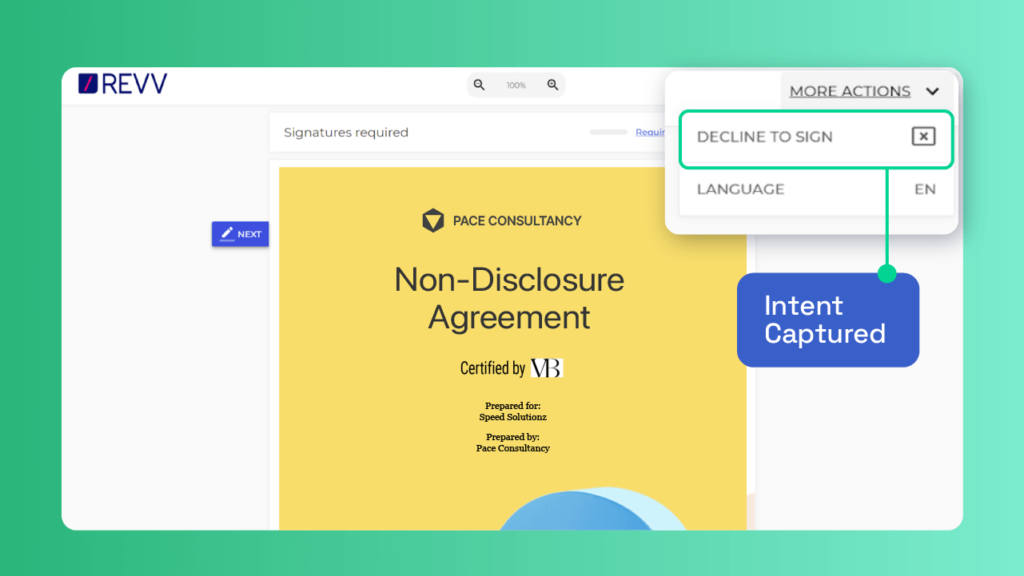
Consent to do business electronically – Revv captures the consent of the signing parties by asking them to click on the ‘Confirm’ button before submitting the document.
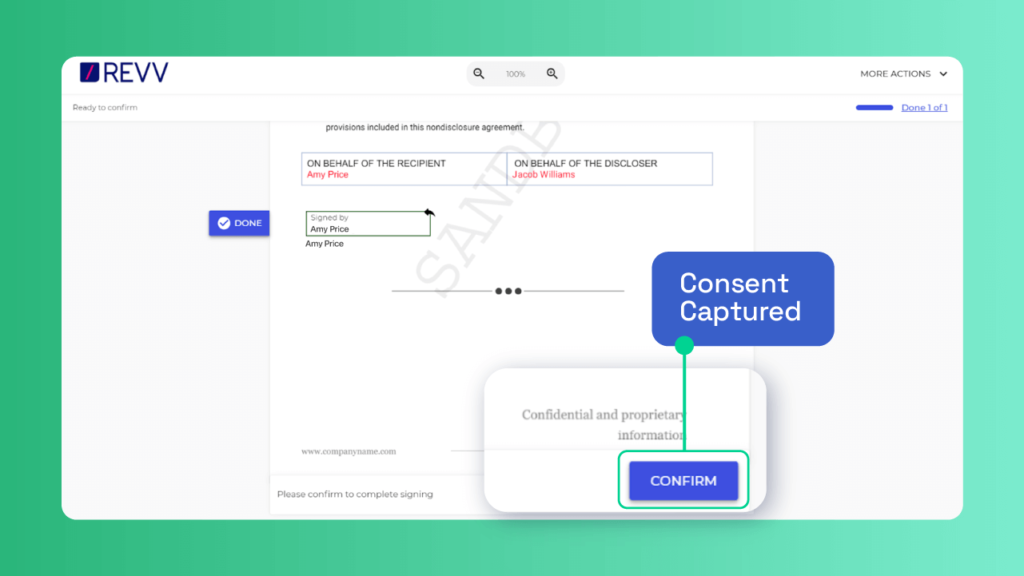
Association of signature with the record – Once a signer completes the signing process, the added eSignatures with date and time stamp become a permanent part of the document.
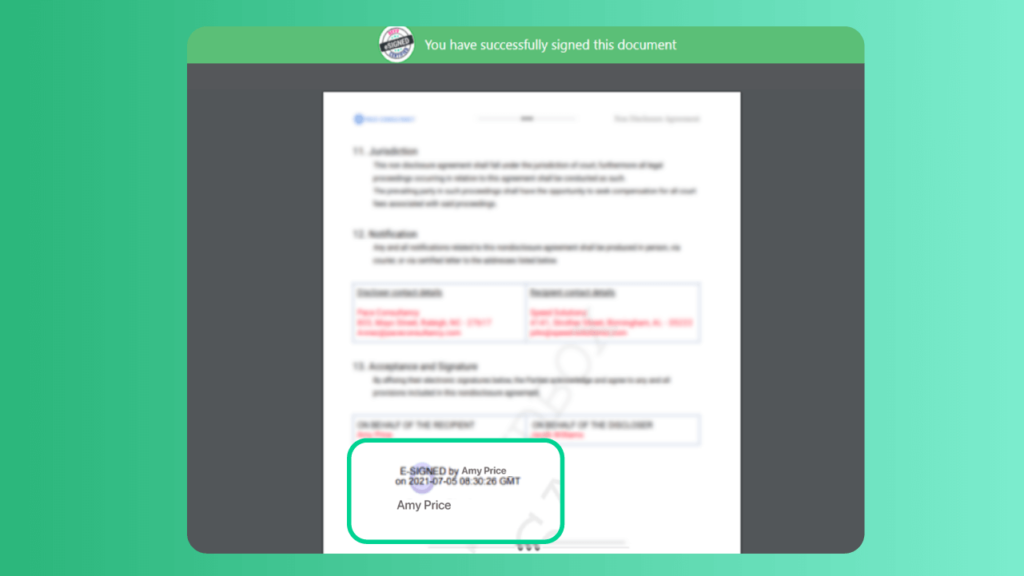
Revv provides an evidence summary with an all-inclusive audit trail. It captures all the details surrounding an electronic transaction like –
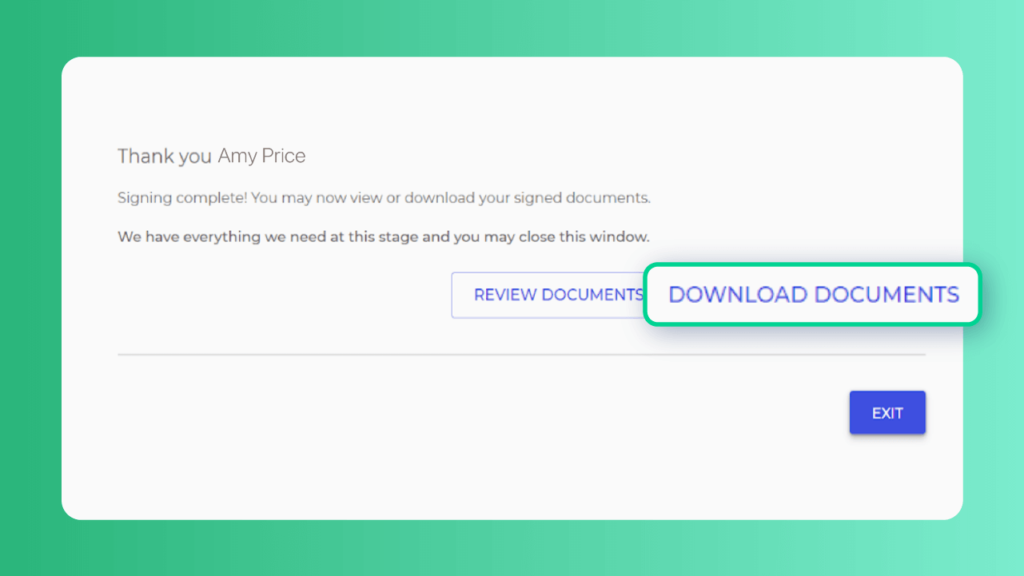
Revv also sends a signed copy of the document to the signing parties via email.
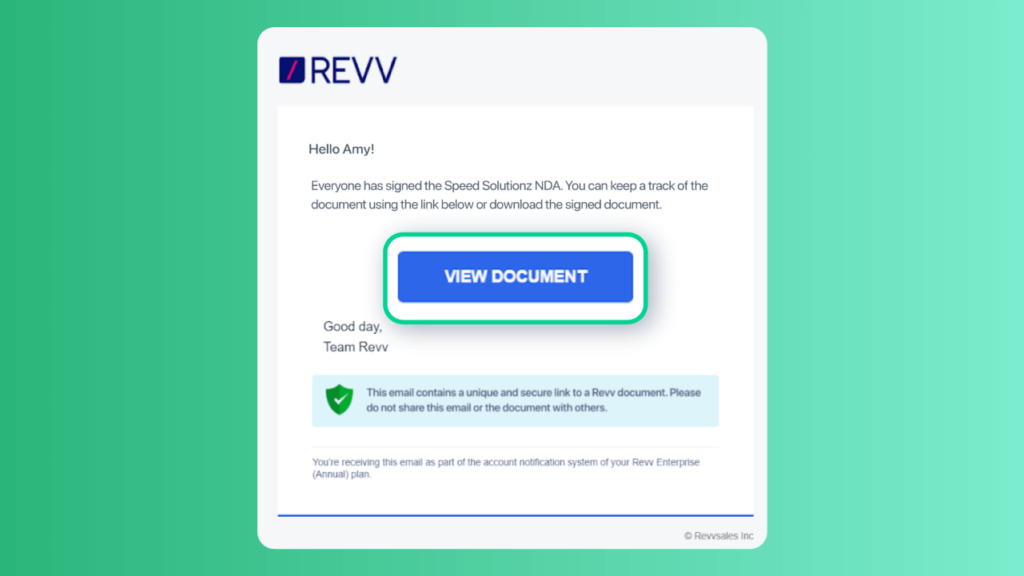
All the signed documents are also stored in Revv’s system and are accessible to users once they sign in to the system.
Revv uses AWS SSE-S3 (Amazon Web Services Server-Side Encryption) to provide a secure and lifetime cloud storage of all signed records.
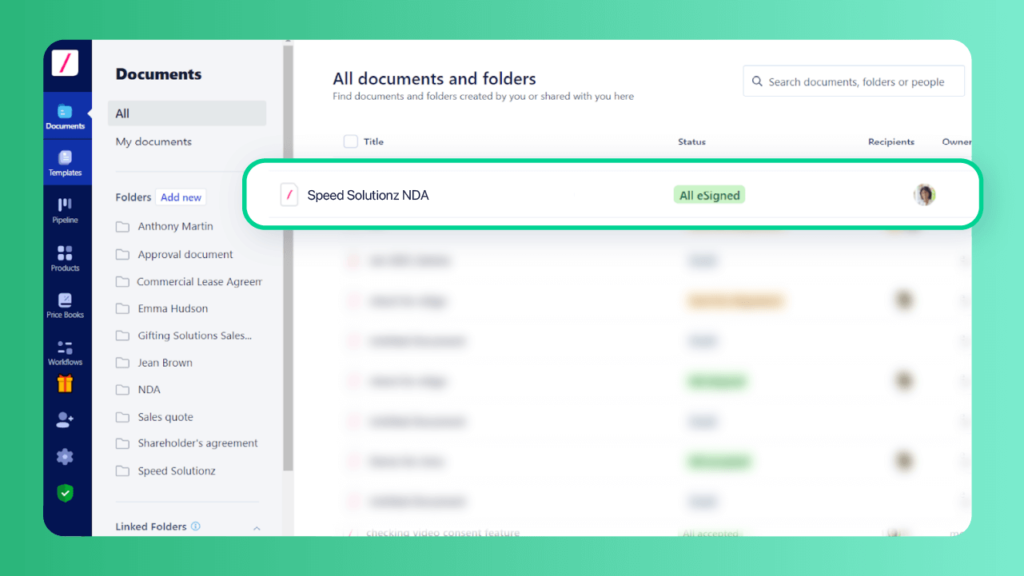
Revv offers a pool of advanced features to empower users with intelligent and seamless electronic signature workflows and help them to speed up the signing process.
| Start your eSignature journey with Revv! Sign up for Free No Risk, No Credit Card Required |
Both ESIGN Act and UETA have created a robust legal landscape to –
Therefore, a compliant eSignature service provider plays a crucial role in abiding by the guidelines of these regulations.
Revv’s compliance with local and global eSignature laws and its modern features makes it a one-stop partner for eSignature and document automation needs.
Professionals, businesses, and enterprises of varied sizes use Revv to run their business anywhere, anytime, and from any device.